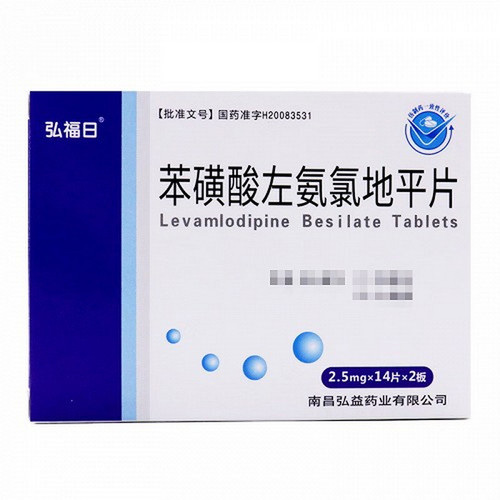Product Overview
[Drug Name]
Generic Name: Levoamlodipine Besylate Tablets
Trade Name: Hongmingyuan Levoamlodipine Besylate Tablets 2.5mg*14 Tablets
Pinyin Code: HongMingYuan BenHuangSuanZuoAnLvDiPingPian 2.5mg*14 Tablets
[Main Ingredients]
The main ingredient of this product is levamlodipine besylate. Chemical name: (S)-{-)3-ethyl-5-methyl-2-(2-aminoethoxymethyl)-4-(2-argonphenyl)-1,4-dihydro-6-methyl-3,5-pyridinedicarboxylate benzenesulfonate. Molecular Formula: C20H25N2O5Cl-C6H6O3S. Molecular Weight: 567.05
[Properties]
This product is white tablets.
[Indications/Main Functions]
1. Hypertension. 2. Angina pectoris.
[Specification]
2.5mg*14 tablets (Yinmo Mingyuan)
[Usage and Dosage]
1. The initial dose for the treatment of hypertension and angina pectoris is 2.5mg, once a day: the dose can be increased according to the patient's clinical response, up to a maximum of 5mg, once a day. 2. This product does not require dose adjustment when used in combination with thiazide diuretics, beta-blockers and angiotensin-converting enzyme inhibitors. [Adverse Reactions] Patients tolerate this product well. (1) Less common side effects are headache, edema, fatigue, insomnia, heart and abdominal pain, flushing, palpitations and dizziness. (2) Very rare side effects are itching, rash, dyspnea, weakness, muscle spasms and indigestion. (3) Similar to other calcium channel blockers, there are very few reports of adverse reactions such as myocardial infarction and chest pain, and these adverse reactions cannot be clearly distinguished from the patient's underlying disease. (4) No abnormal laboratory test parameters related to this product have been found.
[Contraindications]
This product is contraindicated in patients allergic to dihydropyridine calcium channel blockers.
[Drug Interactions]
1. This product is safe for combination with the following drugs: thiazide diuretics, beta-blockers, angiotensin-converting enzyme inhibitors, long-acting nitrates, sublingual nitroglycerin, nonsteroidal anti-inflammatory drugs, antibiotics, and oral hypoglycemic agents. 2. In healthy volunteers, combination use of this product with digoxin did not alter digoxin plasma concentrations or renal clearance; and its pharmacokinetics were not altered when combined with cimetidine. 3. In vitro data indicate that this product has no effect on the plasma protein binding of digoxin, phenytoin, warfarin, or indomethacin. 4. In healthy male volunteers, combination use of this product with warfarin did not affect the changes in prothrombin time induced by warfarin.
[Precautions]
1. As with all calcium channel blockers, this product should be used with caution in patients with impaired hepatic function. 2. For use in patients with renal failure. Patients with impaired renal function can use the normal dose. 3. This product is not suitable for dialysis.
[Pediatric Use]
There are no data available for the use of this product in children.
[Elderly Use]
Elderly patients can use the normal dose. However, it is advisable to start with a lower dose and then gradually increase it.
[Overdose]
1. In the event of an overdose with this product, gastric lavage may be performed. 2. If significant hypotension occurs, active cardiovascular support is required, including monitoring of cardiac and pulmonary function, limb elevation, and monitoring of circulation and urine output. 3. To restore vascular tone and blood pressure, vasoconstrictors may be used if there are no contraindications. 4. Intravenous calcium gluconate may also be beneficial in reversing the effects of calcium antagonists. 5. Because this product is highly bound to plasma proteins, dialysis is ineffective for overdose.
[Pharmacology and Toxicology]
1. This drug is a calcium influx blocker (also known as a calcium channel blocker or calcium ion antagonist), which blocks the entry of extracellular calcium ions into myocardial and vascular smooth muscle cells through calcium ion channels (slow channels) in the cell membrane. 2. This drug directly relaxes vascular smooth muscle and has antihypertensive effects. 3. The mechanism of action of this drug in relieving angina pectoris has not been fully determined, but it alleviates myocardial ischemia through the following actions: ① Dilation of peripheral arterioles, reducing peripheral resistance (afterload), thereby reducing myocardial energy consumption and oxygen demand. ② Dilation of coronary arteries and coronary arterioles in normal and ischemic areas, increasing myocardial oxygen supply in patients with coronary artery spasm (variant angina).
4. This drug undergoes prolonged metabolism in the liver. Like all other calcium antagonists, caution should be exercised when used in patients with impaired liver function.







